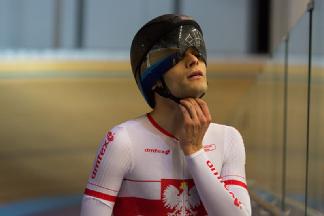WMG News
WMG joins flagship electrification partnership
WMG at the University of Warwick, is part of a unique six-way partner collaborative research and development project led by Aston Martin.
Project ELEVATION has received £9m funding from the Advanced Propulsion Centre UK (APC) to supplement the research and development of Aston Martin’s in-house bespoke luxury battery electric vehicle platform.
Awarded following a competitive process, the government grant will support the development of Aston Martin’s luxury BEV platform and enable a route to net-zero, including investment in vehicle light weighting, a digital toolchain and electrification training.
Project ELEVATION is led by Aston Martin, and supported by the Manufacturing Technology Centre; Expert Tooling & Automation; Creative Composites; Fuzzy Logic Studio and WMG. The project will address the technical challenges of developing a lightweight, 800V traction battery pack and twin front electric drive unit (EDU) into a modular BEV platform with a bandwidth from supercar to SUV.
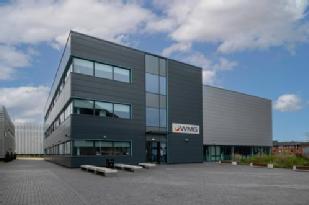 WMG’s role will focus on supporting the design, manufacture and life-cycle analysis (LCA) of the modular structural composite battery enclosure. Researchers in the composites group based in WMG's Materials Engineering Centre (MEC) will conduct materials evaluation and investigate automated high-volume composite manufacturing of hybrid structures using existing tooling and equipment to demonstrate attributes on early learning components. This knowledge will then be transferred to Creative Composites for manufacture of the project demonstrator components and provide LCA of the composite structure into the Manufacturing Technology Centre's holistic LCA model.
WMG’s role will focus on supporting the design, manufacture and life-cycle analysis (LCA) of the modular structural composite battery enclosure. Researchers in the composites group based in WMG's Materials Engineering Centre (MEC) will conduct materials evaluation and investigate automated high-volume composite manufacturing of hybrid structures using existing tooling and equipment to demonstrate attributes on early learning components. This knowledge will then be transferred to Creative Composites for manufacture of the project demonstrator components and provide LCA of the composite structure into the Manufacturing Technology Centre's holistic LCA model.
Roberto Fedeli, Group Chief Technology Officer of Aston Martin, said: “The award of funding from the APC is another major boost to our electrification strategy and constant strive for innovation. Providing further resources to explore the possibilities of our bespoke BEV platform, it will help achieve our ambition to be an in-house BEV technology leader in the ultra-luxury, high-performance segment. We look forward to progressing this project with our collaborative partners and thank the APC for their incredible support.”
Ian Constance, APC Chief Executive, said: “The 23rd round of our collaborative R&D competition coincides with the APC’s 10th anniversary. We’ve seen over £1.4 billion of investment into automotive projects since the APC was set up, and I am proud of the impact that we have made here in the UK. This latest announcement includes a diverse set of OEMs and suppliers that demonstrate the strength of UK automotive. They will further add to our portfolio of innovative projects and continue to drive the UK to deliver on its net zero ambition.”
Find out more about WMG’s composite light-weighting research here https://warwick.ac.uk/fac/sci/wmg/research/materials/acrc
Flagship Coventry transport project takes a major step forward to net zero
- Real-world urban highway demo site of innovative rail track system for Coventry Very Light Rail (CVLR) unveiled on University of Warwick campus
- Testing facility will allow simulation of various scenarios, enabling active engagement with key stakeholders including utility companies and city transport planners
- WMG and Ingerop engineers have capitalised on advanced material and manufacturing processes developed over recent years
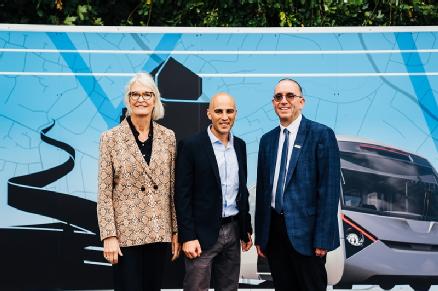 The Coventry Very Light Rail Project (CVLR) has taken a major step forward, as Coventry City CouncilLink opens in a new window and WMG, at the University of Warwick, launch a real-world demo site for its light rail track system.
The Coventry Very Light Rail Project (CVLR) has taken a major step forward, as Coventry City CouncilLink opens in a new window and WMG, at the University of Warwick, launch a real-world demo site for its light rail track system.
The site, based at WMG, University of Warwick, gives stakeholders a snapshot of what’s to come in Coventry, when the first phase of the city route commences.
Using advanced material and manufacturing processes, researchers and engineers at WMG have worked alongside track-design experts at IngeropLink opens in a new window to create, design and build the demo site including the unique track system, which is not only more affordable to install but also enables rapid installation - minimising disruption to local properties and businesses.
The track form, designed to sit within the top 30cm of existing highway surfaces, is easy to install and can be removed rapidly; significantly reducing clashes with utilities and potentially saving millions of pounds otherwise spent on excavation and moving gas, electrical and telecommunication systems when installing more traditional track forms. With installation costed at approximately £10m per km, the track is significantly cheaper compared to current tram tracks which can cost upwards of £25m per km, and significantly more in city centre locations.
The new track has been developed in parallel to a zero-emission, battery-powered lightweight shuttle vehicle created in partnership with TDi. The vision of Coventry Very Light Rail is that as technology matures it will become autonomous and work similarly to the London Underground system, where service is frequent and passengers can hop on and off.
The vehicle itself is lightweight, and there will be no overhead power supply along the route, significantly reducing infrastructure costs, complexity and visual impact on the city-scape.
Councillor Jim O’Boyle, Cabinet Member for Jobs, Regeneration and Climate Change, said: “This new track test site is a key part of our work to demonstrate the viability of the breakthrough technology in this track. In a world first, we’re aiming to keep pipes and cables in the ground, lowering installation costs and making Coventry Very Light Rail possible in our city and across the country.
“Coventry Very Light Rail will form the backbone of our future transport network, but we’re investing in many projects to make our city’s transport cleaner, greener and more convenient for residents. Coventry Very Light Rail will fit seamlessly with our plans to be the UK's first all-electric bus city and our plans to continue to provide more on-street electric charge points than anywhere outside London.”
Following installation at the University of Warwick, Coventry City Council will install test track at its Whitley Depot waste facility to test it with heavy goods vehicles, and also at the Very Light Rail National Innovation Centre (VLRNIC) in Dudley, where vehicle testing is currently taking place. The installation will form part of the facility’s 15m radius loop, built to test the CVLR prototype vehicle’s cornering system and will enable full system integration testing to be undertaken.
Dr Christopher Micallef, Principal Engineer at WMG, University of Warwick comments: “The University of Warwick urban track demonstration site provides an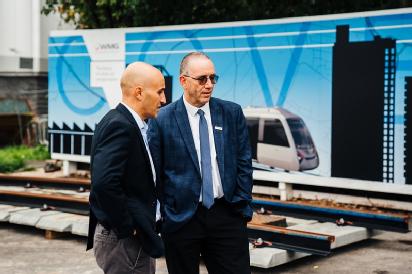 ideal scenario to prove-out the installation methods of the novel track system. The site will enable various competing sub-systems such as the encapsulation and pavement systems to be trialled to further explore the advantages and challenges.
ideal scenario to prove-out the installation methods of the novel track system. The site will enable various competing sub-systems such as the encapsulation and pavement systems to be trialled to further explore the advantages and challenges.
“The site includes features such as water drainage gullies, buried utilities and a sewage access chamber to ensure that solutions to these real-world complexities can be explored. After the first phase, which is all about the track installation process, the site will be further utilised to allow various scenarios to be simulated and enable active engagement with key stakeholders such as utility companies, materials and subsystems supply chain and city transport planners. Eventually it could provide a facility to train the next generation of track installation teams.”
Andy Street, Mayor of the West Midlands, said: “This very light rail project is a fantastic demonstration of collaboration across our region – whether it’s the development at Dudley, this new test track at Warwick University or soon enough the first route in Coventry city centre.
“The West Midlands Combined Authority is investing £71.5m into very light rail. Designing and building a light rail service rapidly and at a fraction of the cost of regular Metro lines has the potential to transform our public transport network. It is also a great example of cutting edge innovation that can help us to meet our #WM2041 net zero commitment and tackle the climate emergency. Our region is ideally placed to become the home of the green industrial revolution.”
Coventry Very Light rail is being led by Coventry City Council and has received funding from the West Midlands Combined Authority, the Coventry and Warwickshire Local Enterprise Partnership and Coventry City Council.
-ENDS-
WMG research recognised at key industry awards
 WMG’s composites manufacturing expertise, on Project TUCANA, has been recognised at the prestigious JEC World Composites Innovation Awards 2022,
WMG’s composites manufacturing expertise, on Project TUCANA, has been recognised at the prestigious JEC World Composites Innovation Awards 2022,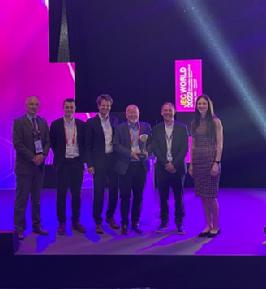 in Paris.
in Paris.
The Awards celebrate innovation in design and manufacturing within the global composites industry. Project TUCANA, led by Jaguar Land Rover in partnership with WMG at the University of Warwick; Expert Tooling & Automation Limited; Broetje-Automation UK Ltd; Toray International U.K. Limited; CCP Gransden Ltd; and CFMS Limited, was announced as the winner of the Automotive and Road Transportation - Structural category.
WMG experts, led by Professor Ken Kendall, helped to develop a stiffer and lighter vehicle structure using light weight carbon fibre composite components.
The research, which took place in the Materials Engineering Centre, has developed world-leading cost effective, scalable carbon fibre composite solutions, with the view to boosting the performance of electric vehicles. Upon adoption of the design philosophy in JLR vehicles the total combined CO2 benefit of the project between 2023-2032 is projected to be 4.5 million tonnes.
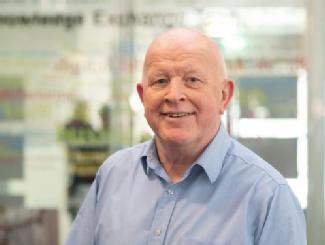 Professor Ken Kendall explains:“Our research helped develop the design and manufacturing technology needed to optimise the vehicle body architecture required for electric vehicles, improving their environmental impact through reduced weight, improved rigidity and range extension.
Professor Ken Kendall explains:“Our research helped develop the design and manufacturing technology needed to optimise the vehicle body architecture required for electric vehicles, improving their environmental impact through reduced weight, improved rigidity and range extension.
“This project has helped develop the understanding of what is achievable through the use of mixed composite materials to improve structural performance at affordable cost for high volume manufacture. WMG were a key partner in developing and demonstrating the technologies required and transitioning this knowledge to our industrial partners. We are delighted that the project has received the recognition it deserves.”
Composites award wins for WMG research
Two WMG research projects, Project AMICABLE and Project TUCANA, were recognised at the Composites Industry Awards this week.
Project AMICABLE, a 12-month Innovate UK funded project, which set out to produce a lightweight, permanently antimicrobial grab pole for use in public transport, won the Innovation in Composite Materials award.
transport, won the Innovation in Composite Materials award.
Researchers from WMG’s Lightweight Materials and Manufacturing team worked with, product designers Transport Design International (TDI), anti-microbial additive developers BioCote and Promethean Particles and the Health and Safety Executive (HSE), and manufacturers Composites Braiding Ltd (CBL), to produce lightweight composite grab-poles with an embedded anti-microbial property.
The anti-microbial grab poles can be used in a wide range of public transport applications, such as bus, tram, rail and underground, helping to reduce transmission of infections.
A second project involving experts from WMG, called Project Tucana and led by Jaguar Land Rover, was recognised in the Innovation in Composite Design category.
The APC funded project is an enabler for future generations of Battery Electric Vehicles (BEV), demonstrated through the redesign of the rear structure of a Jaguar I-Pace, the acclaimed Jaguar Land Rover (JLR) BEV, bringing together a consortium of world-leading academic and industry partners. Researchers and engineers from WMG’s Automotive Composites Research Centre helped to develop the manufacturing technology to design stiffer and lighter vehicle structures using light weight carbon fibre materials.
Read more about the Composites Industry Awards here: Composites Industry Awards | Composites UK
WMG helps Senior Teaching Fellow break cycling world record
In a bid to fulfil a two-year ambition, Senior Teaching Fellow Piotr Klin teamed up with WMG to prepare the race package for his UCI World Masters Hour record attempt on July 21st.
Scooping the cycling accolade at his native Polish velodrome of Arena Pruszkow, Piotr’s distance of 49.649km beat the previous record for the 30-34 age group of 48.234km set by Britain’s Ryan Davies.
The World Masters Hour concept requires racers to ride around a velodrome and cover the furthest distance within 60 minutes. Having narrowly missed out on breaking the Polish hour record in August last year, Piotr collaborated with WMG at the University of Warwick to make technical advancements to his bike, utilising the state-of-the-art facilities at WMG.
Piotr reviewed the 3D printed parts within his bike to minimise the drag on the track, and commenting on his successes, the Coventry resident originally from Lublin in Poland said:
“This is a great achievement for me, and it feels extra special to do this in my home country. The extra time that I have spent training in the velodrome has paid off. WMG manufactured parts were custom made to best fit my body, using 3D scanning and printing techniques to deliver a custom cockpit fit, providing comfort during the longest hour in cycling.
“By leveraging the world-leading expertise and facilities through my collaboration with WMG, I’ve been able to bring the best race package I’ve had to-date and deliver this world record performance.
“I’m excited for new challenges following this milestone and look forward to collaborating with WMG further to post even faster times.”
By breaking the world record, Piotr added a further feather to his cap, which already includes a well decorated repertoire of accolades, including merits for being a three-time Polish Masters National Time Trial champion and his crown of Amateur Sportsman of the Year from the 2018 Coventry and Warwickshire Sports Awards.
Building on his successes, Piotr now hopes to go one better than his second place in 2017 at the UCI Gran Fondo World Championships Time Trial in Poznan in August.
Minister shown how WMG literally weaved design of Very Light Rail – Braided structure lightweight
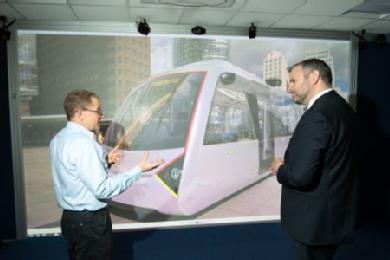 WMG, at the University of Warwick, has worked with partners, to create a new design of incredibly lightweight Very Light Rail (VLR) vehicle frame which is weaved, or braided, from carbon fibre composites into a series of tubes to create a first prototype demonstrator frame. Parliamentary Under Secretary of State and Minister for Business and Industry Andrew Stephenson became one of the very first people to see the new design, outside of the research partnership, on a visit to WMG on 16th May.
WMG, at the University of Warwick, has worked with partners, to create a new design of incredibly lightweight Very Light Rail (VLR) vehicle frame which is weaved, or braided, from carbon fibre composites into a series of tubes to create a first prototype demonstrator frame. Parliamentary Under Secretary of State and Minister for Business and Industry Andrew Stephenson became one of the very first people to see the new design, outside of the research partnership, on a visit to WMG on 16th May.
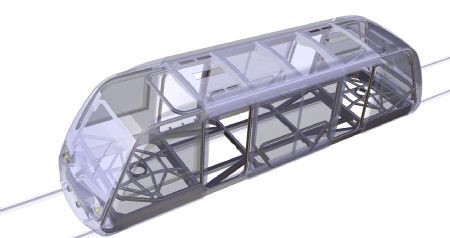 Working with the lightweight structural composite components company Far, and Transport Design International Ltd in Stratford upon Avon the demonstrator can be easily assembled by adhesive and simple welding.
Working with the lightweight structural composite components company Far, and Transport Design International Ltd in Stratford upon Avon the demonstrator can be easily assembled by adhesive and simple welding.
Dr Darren Hughes Associate Professor in Materials and Manufacturing at WMG at the University of Warwick said:
“Our BRAINSTORM VLR research partnership has achieved significant weight-saving, allowing VLR services to accommodate more passengers while reducing the energy required to propel the vehicle and the weight stress it will place on its rails and road surface.”
“The technology also ensures that the vehicle is tough for a long life in service, easily repairable when accidents happen and strong enough to protect the passengers on board.”
The innovative highly efficient very light weight approach consists of an underlying tubular spaceframe chassis which provides the body shell. In the first demonstrator frame the partners have produced they were able to keep the beams the same outside diameter but their wall thickness is tailored to give the optimum performance depending on where it will be used. This keeps the tooling costs low and allows for all the joining to be standardised through a combination of welding and adhesive bonding.
If any significant damage is caused to any individual beam through an accidental impact each damaged beam can simply be entirely replaced with a new one. Best of all the thermoplastic material is inherently recyclable.
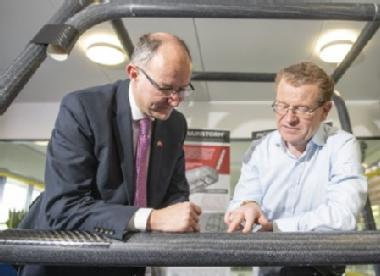 The whole moulding cycle has been shown to be capable of being reduced to less than five minutes, demonstrating the potential of this affordable process for high-volume applications. The braiding process is highly automated and with rates of over a mile a day of braided tubing.
The whole moulding cycle has been shown to be capable of being reduced to less than five minutes, demonstrating the potential of this affordable process for high-volume applications. The braiding process is highly automated and with rates of over a mile a day of braided tubing.
This braiding method also allows for a wide range of materials to be used. Almost any fibres (carbon, glass and aramid) can be combined with a huge range of thermoplastics, from low cost Polypropylene to high end Polyether ether ketone (PEEK) to create a material that suits the given application
Lyndon Sanders Director and General Manager of Nottingham based lightweight structural composite components company Far said:
“The BRAINSTORM Project feels like a real step forward to the team at Far Composites. Being able to tap into the industry experience of TDI to hone the principle of a new type of body structure for mass transit applications was great. Add to that the collaborative working with Composites Braiding and WMG to turn that thinking into a physical demonstrator to show what it would be like in practice was really powerful. Now it’s more than a good idea, now it’s an eye opener for industry players who can see it, touch it and even pick it up.”
ENDS
20 MAY 2019
Note for Editors:
High-res images available, please credit The University of Warwick:
The design of the frame with some other sections attached
https://warwick.ac.uk/services/communications/medialibrary/images/april2019/frame-cb1-2.jpg
Dr Darren Hughes (right) showing Lyndon Sanders Director and General Manager of Far (left of picture) the braiding pattern on the frame
https://warwick.ac.uk/services/communications/medialibrary/images/april2019/train_2_jpeg.jpg
Dr Darren Hughes Associate Professor in Materials and Manufacturing at WMG at the University of Warwick (left) showing Parliamentary Under Secretary of State and Minister for Business and Industry Andrew Stephenson (right of picture) all the design stages of the VLR vehicle
https://warwick.ac.uk/services/communications/medialibrary/images/may2019/brainstorm_pic.jpg
The frame with less attached
https://warwick.ac.uk/services/communications/medialibrary/images/april2019/frame-cb5-1.jpg
Another view
https://warwick.ac.uk/services/communications/medialibrary/images/april2019/frame-cb2-1.jpg
A further view
https://warwick.ac.uk/services/communications/medialibrary/images/april2019/frame-cb9-1.jpg
The Full list of partners on the project are: WMG at the University of Warwick, the UK's Governments innovation agency Innovate UK, Far composites, Composite Braiding ,and Transport Design International Ltd in Stratford upon Avon
For further information please contact:
Alice Scott
Media Relations Manager – Science
University of Warwick
Tel: +44 (0) 2476 574 255 or +44 (0) 7920 531 221
E-mail: alice.j.scott@warwick.ac.uk

